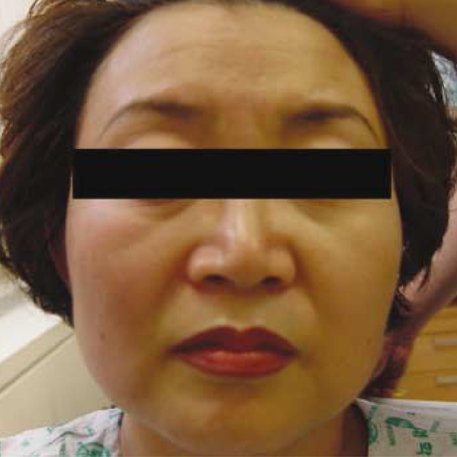J Korean Med Sci.
2005 Apr;20(2):329-330. 10.3346/jkms.2005.20.2.329.
Harlequin Syndrome with Crossed Sympathetic Deficit of the Face and Arm
- Affiliations
-
- 1Department of Neurology, College of Medicine, Seoul National University, Seoul National University Bundang Hospital, Seongnam, Korea. jisookim@snu.ac.kr
- KMID: 1095214
- DOI: http://doi.org/10.3346/jkms.2005.20.2.329
Abstract
- Harlequin syndrome is characterized by unilateral hyperhidrosis and flushing, which are predominantly induced by heat or exercise. Usually, the sympathetic deficits confine to the face. Rarely, the autonomic deficits involve the arm or the parasympathetic neurons in the ciliary ganglia. We report a 43-yr-old woman who presented with facial flushing and sweating in the right side, which were mainly induced by exercise. The facial flushing accompanied relative coldness in the right arm. Valsalva maneuver, cold pressure and 0.125% pilocarpine test, and computed tomography of the chest were normal. The crossed sympathetic deficit in the left face and right arm suggested that the lesions were multifocal. The sympathetic impairment in our patient may lie on a spectrum of pre- and postganglionic autonomic dysfunction, which was observed in Holmes-Adie, Ross, and Guillain-Barre syndrome.
Keyword
MeSH Terms
Figure
Reference
-
1. Lance JW, Drummond PD, Gandevia SC, Morris JG. Harlequin syndrome: the sudden onset of unilateral flushing and sweating. J Neurol Neurosurg Psychiatry. 1988. 51:635–642.
Article2. Noda S. Harlequin syndrome due to superior mediastinal neurinoma. J Neurol Neurosurg Psychiatry. 1991. 54:744.
Article3. Coleman PJ, Goddard JM. Harlequin syndrome following internal jugular vein catheterization in an adult under general anesthetic. Anesthesiology. 2002. 97:1041.
Article4. Charkoudian N. Skin blood flow in adult human thermoregulation: how it works, when it does not, and why. Mayo Clin Proc. 2003. 78:603–612.
Article5. Drummond PD. Sweating and vascular responses in the face: normal regulation and dysfunction in migraine, cluster headache and harlequin syndrome. Clin Auton Res. 1994. 4:273–285.
Article6. Corbett M, Abernethy DA. Harlequin syndrome. J Neurol Neurosurg Psychiatry. 1999. 66:544.
Article7. Caparros-Lefebvre D, Hache JC, Hurtevent JF, Dereeper O, Bille F, Petit H. Unilateral loss of facial flushing and sweating with contralateral anhidrosis: harlequin syndrome or Adie's syndrome? Clin Auton Res. 1993. 3:239–241.
Article8. Kim JS, Yun CH, Moon CS. Bilateral tonic (Adie's) pupils in Vogt-Koyanagi-Harada syndrome. J Neuroophthalmol. 2001. 21:205–206.
Article9. Choi MJ, Choi DG, Kim SY. A case of Ross' syndrome with Horner's syndrome. J Korean Ophthalmol Soc. 1998. 39:2201–2205.10. Kim KK. Tonic pupil in neuropathy. J Korean Neurol Assoc. 2000. 18:420–424.11. Drummond PD, Edis RH. Loss of facial sweating and flushing in Holmes Adie syndrome. Neurology. 1990. 40:847–849.12. Shin RK, Galetta SL, Ting TY, Armstrong K, Bird SJ. Ross syndrome plus: Beyond Horner, Holmes-Adie, and harlequin. Neurology. 2000. 55:1841–1846.
Article


